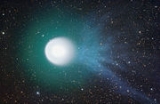
17P/Holmes
Encyclopedia
Comet Holmes is a periodic comet in our solar system
, discovered by the British amateur astronomer Edwin Holmes on November 6, 1892. Although normally a very faint object, Holmes became notable during its October 2007 return when it temporarily brightened by a factor of about half a million, in what was the largest known outburst by a comet, and became visible to the naked eye. It also briefly became the largest object in the solar system, as its coma
(the thin dissipating dust ball around the comet) expanded to a diameter greater than that of the Sun (although its mass
remained minuscule).
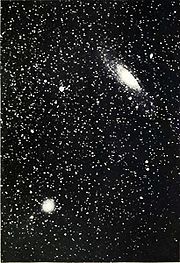 Comet Holmes was discovered by Edwin Holmes on November 6, 1892, while he was conducting regular observations of the Andromeda Galaxy
Comet Holmes was discovered by Edwin Holmes on November 6, 1892, while he was conducting regular observations of the Andromeda Galaxy
(M31). Its discovery in 1892 was possible because of an increase in its magnitude
similar to the 2007 outburst; it brightened to an approximate magnitude of 4 or 5 before fading from visibility over a period of several weeks.
The comet's discovery was confirmed by Edward Walter Maunder
(Royal Observatory
, Greenwich
, England
), William Henry Maw (England
), and Kidd (Bramley
, England
) and independent discoveries were made by Thomas David Anderson
(Edinburgh
, Scotland
) on November 8 and by Mike Brown (Wilkes, USA) and by John Ewen Davidson (Mackay
, Queensland
, Australia
) on November 9.
The first calculations of the elliptical orbits of 17P/Holmes were done independently by Heinrich Kreutz
and George Mary Searle
. Additional orbits eventually established the perihelion date as June 13 and the orbital period
as 6.9 years. These calculations proved that the comet was not a return of Biela's Comet.
The 1899 and 1906 appearances were observed, but the comet was lost (see Lost comet
) after 1906 until it was recovered on July 16, 1964, by Elizabeth Roemer
(US Naval Observatory Flagstaff Station, Arizona
, USA). Aided by the computer predictions of Brian G. Marsden
, the comet has been observed on every subsequent return.
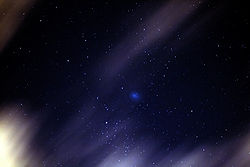 During its 2007 return, Holmes unexpectedly brightened from a magnitude
During its 2007 return, Holmes unexpectedly brightened from a magnitude
of about 17 to about 2.8 in a period of only 42 hours, making it visible to the naked eye. This represents a change of brightness by a factor of about half a million and is the largest known outburst by a comet. The outburst took place from October 23 to 24, 2007. The first person reportedly to notice a change was J. A. Henríquez Santana on Tenerife
in the Canary Islands
; minutes later, Ramón Naves in Barcelona
noticed the comet at magnitude 7.3. It became easily visible to the naked eye
as a bright yellow "star" in Perseus
, and by October 25 17P/Holmes appeared as the third brightest "star" in that constellation.
While large telescopes had already shown fine-scale cometary details, naked-eye observers saw Holmes as merely star-like until October 26. After that date, 17P/Holmes began to appear more comet-like to naked-eye observers. This is because during the comet's outburst, its orbit took it to near opposition
with respect to Earth, and since comet tails point away from the Sun, Earth observers were looking nearly straight down along the tail of 17/P Holmes, making the comet appear as a bright sphere.
Based on orbital computations and luminosity before the 2007 outburst, the comet's nucleus
was estimated at 3.4 km.
The comet did not only become brighter, it also swelled in size, as its coma expanded. In late October 2007 the coma's
apparent diameter increased from 3.3 arcminutes to over 13 arcminutes, about half the diameter that the Moon subtends in the sky. At a distance of around 2 AU
, this means that the true diameter of the coma had swelled to over 1 million km, or about 70% of the diameter of the Sun
. By comparison, the Moon
is 380,000 km from Earth
. Therefore, during the 2007 outburst of Comet Holmes the coma was a sphere wider than the diameter of the Moon
's orbit around Earth
. On 2007 November, the coma had dispersed to an area larger than the sun, briefly giving it the largest extended atmosphere in the solar system.
The cause of the outburst is not definitely known. The huge cloud of gas and dust may have resulted from a collision with a meteoroid
, or, more probably, from a build-up of gas inside the comet's nucleus
which eventually broke through the surface. However, researchers at the Max Planck Institute suggest in a paper published in Astronomy and Astrophysics
that the brightening can be explained by a thick, air-tight dust cover and the effects of H2O sublimation, with the comet's porous structure providing more surface area for sublimation, up to one order of magnitude greater. Energy from the Sun – insolation – was stored in the dust cover and the nucleus within the months before the outburst.
The comet remained visible in February 2008 though it had become a challenging target at about magnitude +5 in the constellation Perseus
. It had expanded to greater than 2 degrees of arc as seen from the Earth, and thus had very little surface brightness.
Solar System
The Solar System consists of the Sun and the astronomical objects gravitationally bound in orbit around it, all of which formed from the collapse of a giant molecular cloud approximately 4.6 billion years ago. The vast majority of the system's mass is in the Sun...
, discovered by the British amateur astronomer Edwin Holmes on November 6, 1892. Although normally a very faint object, Holmes became notable during its October 2007 return when it temporarily brightened by a factor of about half a million, in what was the largest known outburst by a comet, and became visible to the naked eye. It also briefly became the largest object in the solar system, as its coma
Coma (cometary)
frame|right|The [[153P/Ikeya-Zhang|comet Ikeya-Zhang]] exhibiting a bright, condensed coma In astronomy, a coma is the nebulous envelope around the nucleus of a comet. It is formed when the comet passes close to the Sun on its highly elliptical orbit; as the comet warms, parts of it sublimate...
(the thin dissipating dust ball around the comet) expanded to a diameter greater than that of the Sun (although its mass
Mass
Mass can be defined as a quantitive measure of the resistance an object has to change in its velocity.In physics, mass commonly refers to any of the following three properties of matter, which have been shown experimentally to be equivalent:...
remained minuscule).
Discovery

Andromeda Galaxy
The Andromeda Galaxy is a spiral galaxy approximately 2.5 million light-years from Earth in the constellation Andromeda. It is also known as Messier 31, M31, or NGC 224, and is often referred to as the Great Andromeda Nebula in older texts. Andromeda is the nearest spiral galaxy to the...
(M31). Its discovery in 1892 was possible because of an increase in its magnitude
Magnitude (astronomy)
Magnitude is the logarithmic measure of the brightness of an object, in astronomy, measured in a specific wavelength or passband, usually in optical or near-infrared wavelengths.-Background:...
similar to the 2007 outburst; it brightened to an approximate magnitude of 4 or 5 before fading from visibility over a period of several weeks.
The comet's discovery was confirmed by Edward Walter Maunder
Edward Walter Maunder
Edward Walter Maunder was an English astronomer best remembered for his study of sunspots and the solar magnetic cycle that led to his identification of the period from 1645 to 1715 that is now known as the Maunder Minimum....
(Royal Observatory
Royal Observatory, Greenwich
The Royal Observatory, Greenwich , in London, England played a major role in the history of astronomy and navigation, and is best known as the location of the prime meridian...
, Greenwich
Greenwich
Greenwich is a district of south London, England, located in the London Borough of Greenwich.Greenwich is best known for its maritime history and for giving its name to the Greenwich Meridian and Greenwich Mean Time...
, England
England
England is a country that is part of the United Kingdom. It shares land borders with Scotland to the north and Wales to the west; the Irish Sea is to the north west, the Celtic Sea to the south west, with the North Sea to the east and the English Channel to the south separating it from continental...
), William Henry Maw (England
England
England is a country that is part of the United Kingdom. It shares land borders with Scotland to the north and Wales to the west; the Irish Sea is to the north west, the Celtic Sea to the south west, with the North Sea to the east and the English Channel to the south separating it from continental...
), and Kidd (Bramley
Bramley
- Places :England* Bramley, Derbyshire* Bramley, Hampshire* Bramley, Rotherham, South Yorkshire* Bramley, Sheffield, South Yorkshire* Bramley, Surrey* Bramley, West Yorkshire**Bramley Buffaloes rugby league clubSouth Africa* Bramley, Gauteng- Other uses :...
, England
England
England is a country that is part of the United Kingdom. It shares land borders with Scotland to the north and Wales to the west; the Irish Sea is to the north west, the Celtic Sea to the south west, with the North Sea to the east and the English Channel to the south separating it from continental...
) and independent discoveries were made by Thomas David Anderson
Thomas David Anderson
Thomas David Anderson was a Scottish amateur astronomer.He was born in Edinburgh. When he was five years old, his father showed him Comet Donati, and his nanny also gave him an interest in astronomy....
(Edinburgh
Edinburgh
Edinburgh is the capital city of Scotland, the second largest city in Scotland, and the eighth most populous in the United Kingdom. The City of Edinburgh Council governs one of Scotland's 32 local government council areas. The council area includes urban Edinburgh and a rural area...
, Scotland
Scotland
Scotland is a country that is part of the United Kingdom. Occupying the northern third of the island of Great Britain, it shares a border with England to the south and is bounded by the North Sea to the east, the Atlantic Ocean to the north and west, and the North Channel and Irish Sea to the...
) on November 8 and by Mike Brown (Wilkes, USA) and by John Ewen Davidson (Mackay
Mackay, Queensland
Mackay is a city on the eastern coast of Queensland, Australia, about north of Brisbane, on the Pioneer River. Mackay is nicknamed the sugar capital of Australia because its region produces more than a third of Australia's cane sugar....
, Queensland
Queensland
Queensland is a state of Australia, occupying the north-eastern section of the mainland continent. It is bordered by the Northern Territory, South Australia and New South Wales to the west, south-west and south respectively. To the east, Queensland is bordered by the Coral Sea and Pacific Ocean...
, Australia
Australia
Australia , officially the Commonwealth of Australia, is a country in the Southern Hemisphere comprising the mainland of the Australian continent, the island of Tasmania, and numerous smaller islands in the Indian and Pacific Oceans. It is the world's sixth-largest country by total area...
) on November 9.
The first calculations of the elliptical orbits of 17P/Holmes were done independently by Heinrich Kreutz
Heinrich Kreutz
Heinrich Carl Friedrich Kreutz was a German astronomer, most notable for his studies of the orbits of several sungrazing comets, which revealed that they were all related objects, produced when a very large sun-grazing comet fragmented several hundred years previously...
and George Mary Searle
George Mary Searle
George Mary Searle was an American astronomer and clergyman.He discovered the asteroid 55 Pandora in 1858. He also discovered six galaxies. In later life he became a member of the Paulist order and taught at the Catholic University of America.-External links:*...
. Additional orbits eventually established the perihelion date as June 13 and the orbital period
Orbital period
The orbital period is the time taken for a given object to make one complete orbit about another object.When mentioned without further qualification in astronomy this refers to the sidereal period of an astronomical object, which is calculated with respect to the stars.There are several kinds of...
as 6.9 years. These calculations proved that the comet was not a return of Biela's Comet.
The 1899 and 1906 appearances were observed, but the comet was lost (see Lost comet
Lost comet
A lost comet is a previously discovered comet that has been missed at its most recent perihelion passage, generally because there is not enough data to reliably calculate the comet's orbit and predict its location....
) after 1906 until it was recovered on July 16, 1964, by Elizabeth Roemer
Elizabeth Roemer
Elizabeth Roemer is an American astronomer whose research interests center on comets and asteroids.She discovered the asteroids 1930 Lucifer and 1983 Bok...
(US Naval Observatory Flagstaff Station, Arizona
Arizona
Arizona ; is a state located in the southwestern region of the United States. It is also part of the western United States and the mountain west. The capital and largest city is Phoenix...
, USA). Aided by the computer predictions of Brian G. Marsden
Brian G. Marsden
Brian Geoffrey Marsden was a British astronomer born in Cambridge, England, and educated at The Perse School in Cambridge, New College, Oxford and Yale University. Dr...
, the comet has been observed on every subsequent return.
2007 outburst

Apparent magnitude
The apparent magnitude of a celestial body is a measure of its brightness as seen by an observer on Earth, adjusted to the value it would have in the absence of the atmosphere...
of about 17 to about 2.8 in a period of only 42 hours, making it visible to the naked eye. This represents a change of brightness by a factor of about half a million and is the largest known outburst by a comet. The outburst took place from October 23 to 24, 2007. The first person reportedly to notice a change was J. A. Henríquez Santana on Tenerife
Tenerife
Tenerife is the largest and most populous island of the seven Canary Islands, it is also the most populated island of Spain, with a land area of 2,034.38 km² and 906,854 inhabitants, 43% of the total population of the Canary Islands. About five million tourists visit Tenerife each year, the...
in the Canary Islands
Canary Islands
The Canary Islands , also known as the Canaries , is a Spanish archipelago located just off the northwest coast of mainland Africa, 100 km west of the border between Morocco and the Western Sahara. The Canaries are a Spanish autonomous community and an outermost region of the European Union...
; minutes later, Ramón Naves in Barcelona
Barcelona
Barcelona is the second largest city in Spain after Madrid, and the capital of Catalonia, with a population of 1,621,537 within its administrative limits on a land area of...
noticed the comet at magnitude 7.3. It became easily visible to the naked eye
Naked eye
The naked eye is a figure of speech referring to human visual perception unaided by a magnifying or light-collecting optical device, such as a telescope or microscope. Vision corrected to normal acuity using corrective lenses is considered "naked"...
as a bright yellow "star" in Perseus
Perseus (constellation)
Perseus is a constellation in the northern sky, named after the Greek hero Perseus. It was one of the 48 constellations listed by the 2nd century astronomer Ptolemy, and remains one of the 88 modern constellations defined by the International Astronomical Union...
, and by October 25 17P/Holmes appeared as the third brightest "star" in that constellation.
While large telescopes had already shown fine-scale cometary details, naked-eye observers saw Holmes as merely star-like until October 26. After that date, 17P/Holmes began to appear more comet-like to naked-eye observers. This is because during the comet's outburst, its orbit took it to near opposition
Opposition (astronomy)
In positional astronomy, two celestial bodies are said to be in opposition when they are on opposite sides of the sky, viewed from a given place . In particular, two planets are in opposition to each other when their ecliptic longitudes differ by 180°.The astronomical symbol for opposition is ☍...
with respect to Earth, and since comet tails point away from the Sun, Earth observers were looking nearly straight down along the tail of 17/P Holmes, making the comet appear as a bright sphere.
Based on orbital computations and luminosity before the 2007 outburst, the comet's nucleus
Comet nucleus
The nucleus is the solid, central part of a comet, popularly termed a dirty snowball. A cometary nucleus is composed of rock, dust, and frozen gases. When heated by the Sun, the gases sublimate and produce an atmosphere surrounding the nucleus known as the coma...
was estimated at 3.4 km.
The comet did not only become brighter, it also swelled in size, as its coma expanded. In late October 2007 the coma's
Coma (cometary)
frame|right|The [[153P/Ikeya-Zhang|comet Ikeya-Zhang]] exhibiting a bright, condensed coma In astronomy, a coma is the nebulous envelope around the nucleus of a comet. It is formed when the comet passes close to the Sun on its highly elliptical orbit; as the comet warms, parts of it sublimate...
apparent diameter increased from 3.3 arcminutes to over 13 arcminutes, about half the diameter that the Moon subtends in the sky. At a distance of around 2 AU
Astronomical unit
An astronomical unit is a unit of length equal to about or approximately the mean Earth–Sun distance....
, this means that the true diameter of the coma had swelled to over 1 million km, or about 70% of the diameter of the Sun
Sun
The Sun is the star at the center of the Solar System. It is almost perfectly spherical and consists of hot plasma interwoven with magnetic fields...
. By comparison, the Moon
Moon
The Moon is Earth's only known natural satellite,There are a number of near-Earth asteroids including 3753 Cruithne that are co-orbital with Earth: their orbits bring them close to Earth for periods of time but then alter in the long term . These are quasi-satellites and not true moons. For more...
is 380,000 km from Earth
Earth
Earth is the third planet from the Sun, and the densest and fifth-largest of the eight planets in the Solar System. It is also the largest of the Solar System's four terrestrial planets...
. Therefore, during the 2007 outburst of Comet Holmes the coma was a sphere wider than the diameter of the Moon
Moon
The Moon is Earth's only known natural satellite,There are a number of near-Earth asteroids including 3753 Cruithne that are co-orbital with Earth: their orbits bring them close to Earth for periods of time but then alter in the long term . These are quasi-satellites and not true moons. For more...
's orbit around Earth
Earth
Earth is the third planet from the Sun, and the densest and fifth-largest of the eight planets in the Solar System. It is also the largest of the Solar System's four terrestrial planets...
. On 2007 November, the coma had dispersed to an area larger than the sun, briefly giving it the largest extended atmosphere in the solar system.
The cause of the outburst is not definitely known. The huge cloud of gas and dust may have resulted from a collision with a meteoroid
Meteoroid
A meteoroid is a sand- to boulder-sized particle of debris in the Solar System. The visible path of a meteoroid that enters Earth's atmosphere is called a meteor, or colloquially a shooting star or falling star. If a meteoroid reaches the ground and survives impact, then it is called a meteorite...
, or, more probably, from a build-up of gas inside the comet's nucleus
Comet nucleus
The nucleus is the solid, central part of a comet, popularly termed a dirty snowball. A cometary nucleus is composed of rock, dust, and frozen gases. When heated by the Sun, the gases sublimate and produce an atmosphere surrounding the nucleus known as the coma...
which eventually broke through the surface. However, researchers at the Max Planck Institute suggest in a paper published in Astronomy and Astrophysics
Astronomy and Astrophysics
* Astronomy and Astrophysics has a 2010 impact factor of 4.410.-See also:*The Astronomy and Astrophysics Review*Advanced Satellite for Cosmology and Astrophysics*Astronomy & Geophysics*Astronomical Journal*Astrophysical Journal...
that the brightening can be explained by a thick, air-tight dust cover and the effects of H2O sublimation, with the comet's porous structure providing more surface area for sublimation, up to one order of magnitude greater. Energy from the Sun – insolation – was stored in the dust cover and the nucleus within the months before the outburst.
The comet remained visible in February 2008 though it had become a challenging target at about magnitude +5 in the constellation Perseus
Perseus (constellation)
Perseus is a constellation in the northern sky, named after the Greek hero Perseus. It was one of the 48 constellations listed by the 2nd century astronomer Ptolemy, and remains one of the 88 modern constellations defined by the International Astronomical Union...
. It had expanded to greater than 2 degrees of arc as seen from the Earth, and thus had very little surface brightness.
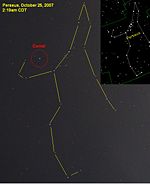 On October 25 the comet looked liked a bright new star in the constellation of Perseus Perseus (constellation) Perseus is a constellation in the northern sky, named after the Greek hero Perseus. It was one of the 48 constellations listed by the 2nd century astronomer Ptolemy, and remains one of the 88 modern constellations defined by the International Astronomical Union... . |
Motion with expanding dust cloud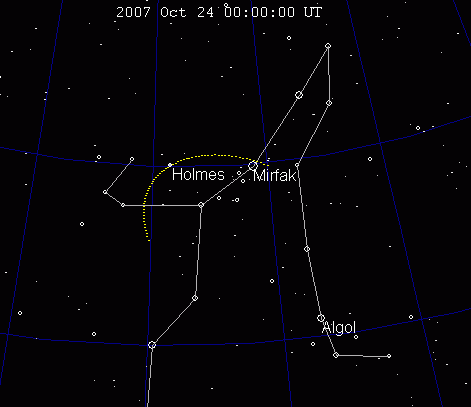 A simulation showing the angular diameter Angular diameter The angular diameter or apparent size of an object as seen from a given position is the “visual diameter” of the object measured as an angle. In the vision sciences it is called the visual angle. The visual diameter is the diameter of the perspective projection of the object on a plane through its... of the expanding dust cloud for 120 days past the initial event on October 24. The surface brightness Surface brightness The overall brightness of an extended astronomical object such as a galaxy, star cluster, or nebula, can be measured by its total magnitude, integrated magnitude or integrated visual magnitude; a related concept is surface brightness, which specifies the brightness of a standard-sized piece of an... decreased over time. |
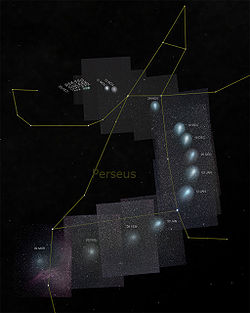 This photo composite shows the comet's size and motion in the constellation Perseus from October 25, 2007 through March 9, 2008. |
Orbit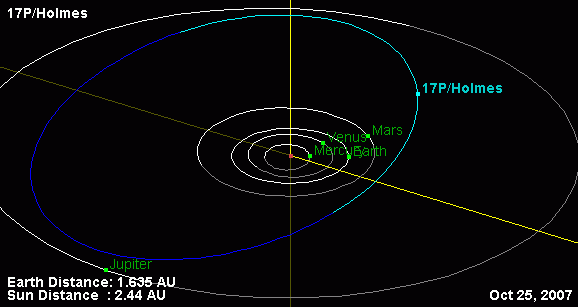 17P/Holmes is a periodic comet in an inclined and elliptical orbit between Mars Mars Mars is the fourth planet from the Sun in the Solar System. The planet is named after the Roman god of war, Mars. It is often described as the "Red Planet", as the iron oxide prevalent on its surface gives it a reddish appearance... and Jupiter Jupiter Jupiter is the fifth planet from the Sun and the largest planet within the Solar System. It is a gas giant with mass one-thousandth that of the Sun but is two and a half times the mass of all the other planets in our Solar System combined. Jupiter is classified as a gas giant along with Saturn,... . The comet was closest to the sun on May 4, 2007. |
||
External links
- 17P at Cometary Science Center
- 17P at Kronk’s Cometography
- 17P at Kazuo Kinoshita's Comets
- 17P at Seiichi Yoshida's Comet Catalog
- Enigmatic Comet Holmes by Jeff Bryant, The Wolfram Demonstrations Project.
- Evolution of Comet 17P/Holmes
- Obscure Comet Brightens Suddenly
- Quick Facts About Comet Holmes
- Simple Instructions on How to Find Comet Holmes Instructions for the Amateur based around Toronto or New York.
- 17P at Las Cumbres Observatory (22 Jan 2010 11:57, 223 seconds)
- Hubble Zooms In on Heart of Mystery Comet (Hubblesite STScI-2007-40 : November 1, 2007)
- NASA's Spitzer Gets Sneak Peek Inside Comet Holmes (October 13, 2008)

